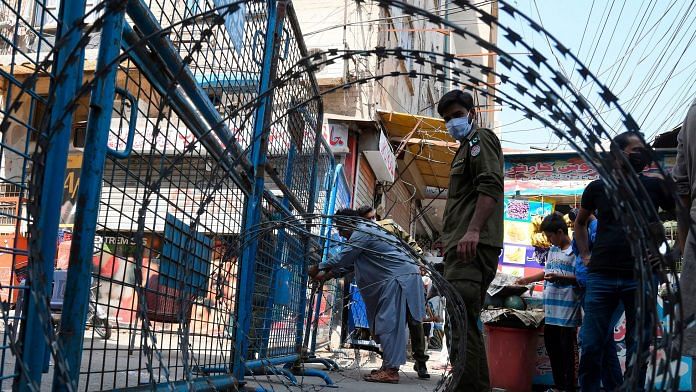Islamabad/Dhaka/Dubai: When Prime Minister Imran Khan addressed Pakistan last week, he thanked higher powers for sparing his country the damage Covid-19 wreaked on neighboring India. While the boast wasn’t unfounded, concerns are growing that new waves emerging around the world could yet devastate the rest of South Asia.
“God saved us from disaster,” Khan said in his six-minute speech. “We came out much better.”
The contrasting impact across South Asia has been striking despite sharing common traits of young populations spread across densely packed cities and expansive hinterlands that struggle to access basic health care. With roughly 1.4 billion people, India has about triple the combined population of Pakistan, Sri Lanka and Bangladesh yet it has reported more than 10 times as many cases.
That partly reflects how the pandemic has been handled. India imposed a sudden national lockdown in March that triggered an exodus of low-paid workers. Rather than starve in the cities, millions returned to their rural villages and many took the disease with them.
Concerned about the economic damage, Pakistan opted for localized lockdowns and drew on the health networks it has in place for an ongoing battle against polio. It also turned to its powerful army to implement track-and-trace systems aided by deep military surveillance. India’s 36 states and union territories instead imposed a patchwork of regulations and enforcement.
With conservative cultures and less dynamic economies, both Bangladesh and Pakistan also have lower rates of domestic travel compared to India, which likely slowed spreading. One of Bangladesh’s top government health officials, Meerjady Sabrina Flora, said the country’s early screening in January also helped.
The disparity is reflected in economic impact. The International Monetary Fund projects India’s economy will shrink 10.3% this year, compared to more muted downturns of 4.6% in Sri Lanka and 0.4% in Pakistan. Bangladesh is the only country expected to grow.
But as subsequent waves now roil the world, fueled by the onset of winter, risks are growing that the entire region could be overrun by the pathogen.
Daily infections have now started to climb in the smaller South Asian nations although those numbers are still dwarfed by India’s current rate of 46,000 daily cases — down from a September peak of nearly 100,000.
“The pandemic is ongoing,” said Bardan Jung Rana, the World Health Organization’s representative in Bangladesh. “Without compliance towards protection measures we can face the scenario of other countries that are experiencing a second wave even more dangerous than the first.”
The usual heavy pollution that blights the air of northern India and Pakistan in winter will likely encourage Covid-19 transmission. Added to that are months of festivals and weddings that prompt huge gatherings, with many largely ignoring social distancing and mask wearing. In an attempt to stem infections, Pakistan banned indoor celebrations this month and curbed attendance to 300.
In Bangladesh, despite government awareness campaigns, Flora said it’s difficult to enforce social distancing in one of the world’s most crowded countries. “Changing people’s behavior is tough,” she said in an interview.
The results in South Asia are muddied by disparities in testing rates and questions about relatively low fatalities.
“In all South Asian settings, the under reporting of deaths continues to be a real limitation,” said Prabhat Jha, a professor at the University of Toronto’s Dalla Lana School of Public Health. Many people prefer to die at home and “we don’t know what is happening in rural areas in particular.”
India has ramped up testing since June to about 0.68 per thousand people a day, according to Our World in Data figures produced by the University of Oxford and Global Change Data Lab. That compares to Pakistan’s 0.16 and Bangladesh’s 0.09.
“There is still some debate on the numbers and the extent to which they reflect low rates of testing,” said Alan Gelb, a senior fellow at the Center for Global Development.
Also read: Nigeria slips into recession, Singapore sees 12 days of no community cases & other Covid news
While Bangladesh has data to understand general trends, Flora said the country doesn’t have a complete picture as many people are scared to come to test centers and hospitals. That left special coronavirus wards largely empty in August and September while Pakistan, like India, saw its health-care system stretched by a rise in virus-related hospitalizations.
“Our neighbors are not testing as systematically or as widely as they should be,” said Gagandeep Khan, a professor of microbiology at the Vellore, India-based Christian Medical College.
Unable to afford further economically damaging lockdowns, many governments in South Asia are now pinning their hopes on a vaccine after a series of positive developments this month.
India is relatively well positioned as drugmakers in the country race to develop a handful of candidates. Other nations in South Asia will be looking to China and a WHO-backed initiative to score supplies. However, any wide roll-out is still likely months, if not years, away.
“We’re on a slippery slope until a vaccine comes,” said Adar Poonawalla, the chief executive officer of the Serum Institute of India Ltd., the world’s largest producer of vaccines by volume. “At least for a year you’re going to see the peaks and troughs coming up in different regions.”- Bloomberg
Also read: Delhi’s Covid death rate increased due to pollution by stubble burning, says Satyendar Jain




Comparing India’s 40000 cases to a country with lower population and an even abysmal rate of testing shows the author knows little about Covid! simply put, if you don’t test, every person is negative for Covid including an infected person. If the strategy of localised lockdowns was so effective in Pakistan, they wouldn’t have been witnessing more than 100% rise in cases in a matter of just two weeks. also, the ride in deaths to double of earlier deaths is proof that the infection data is indeed not an aberration. Test more and you get the true picture.